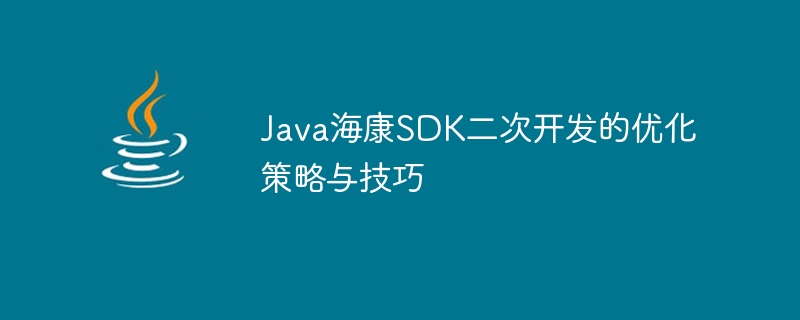Home >Java >javaTutorial >Optimization strategies and techniques for secondary development of Java Hikvision SDK
Optimization strategies and techniques for secondary development of Java Hikvision SDK
- 王林Original
- 2023-09-06 11:55:471194browse

Optimization strategies and techniques for secondary development of Java Hikvision SDK
1. Overview
Hikvision is a leading provider of security products and solutions in China Its SDK provides a rich set of functional interfaces and tools to facilitate developers for secondary development. However, as the project scale expands and the functional complexity increases, the optimization of performance and efficiency has become the focus of developers. This article will introduce some optimization strategies and techniques for secondary development of Java Hikvision SDK, and attach corresponding code examples to help developers improve development efficiency and system performance.
2. Reduce duplicate connections
When using Hikvision SDK, we often need to perform multiple connection operations. In large-scale concurrency situations, frequent connections will put certain pressure on system performance. In order to reduce connection time and improve connection efficiency, you can use connection pooling to reuse existing connections.
Sample code:
HCSadpService sadpService = HCSadpService.getInstance();
sadpService.start();
DeviceInfo[] deviceInfos = sadpService.getDevices();
for(DeviceInfo deviceInfo : deviceInfos) {
HCSdk sdk = new HCSdk();
sdk.logout();
sdk.login(deviceInfo);
// 其他操作
sdk.logout();
}
sadpService.stop();In the above code, we use the connection pool method, first instantiating a HCSadpService object, through getDevices()Method to obtain connected IP device information. Then connect multiple devices through a loop, calling the logout() method before each connection to ensure that each connection is disconnected. This can effectively avoid connection being occupied or connection timeout problems.
3. Exception handling optimization
Exception handling is an essential part when conducting secondary development of Hikvision SDK. However, improper exception handling can lead to program performance degradation or even system crash. Therefore, reasonable exception handling is the key to ensuring stable operation of the system.
In Hikvision SDK, common exceptions include network connection abnormalities, device offline, device timeout, etc. We can solve these problems through reasonable exception catching and handling.
Sample code:
try {
// 海康SDK操作
} catch(NetException e) {
// 网络连接异常处理
e.printStackTrace();
} catch(DeviceOfflineException e) {
// 设备离线异常处理
e.printStackTrace();
} catch(Exception e) {
// 其他异常处理
e.printStackTrace();
} finally {
// 释放资源
}In the above code, we use try-catch to capture different exceptions and handle them accordingly. In this way, even if an exception occurs during operation, the normal operation of the program can be guaranteed, and error logs can be recorded for later analysis.
4. Thread Management
In the case of large-scale concurrency, reasonable thread management can improve the concurrent processing capability of the system. In the secondary development of Hikvision SDK, the thread pool can be used to manage the startup and shutdown of multi-threads.
Sample code:
ThreadPoolExecutor threadPool = new ThreadPoolExecutor(corePoolSize, maximumPoolSize, keepAliveTime, TimeUnit.SECONDS, new LinkedBlockingQueue<Runnable>());
for(DeviceInfo deviceInfo : deviceInfos) {
threadPool.execute(new Runnable() {
@Override
public void run() {
// 海康SDK操作
}
});
}
threadPool.shutdown();In the above code, we use ThreadPoolExecutor to create a thread pool and add tasks to the thread pool for execution through a loop. The thread pool can control the number of concurrent threads to avoid excessive consumption of resources by the system. After all tasks are executed, call the shutdown() method to release thread pool resources.
5. Resource Release
During the secondary development of Hikvision SDK, attention should be paid to timely release of resources, including closing connections, cleaning up memory, and recycling resources. Failure to release resources in time may cause memory leaks or resource exhaustion during system operation.
Sample code:
HCSdk sdk = new HCSdk(); // 海康SDK操作 sdk.logout(); sdk.cleanup(); sdk.cleanupPlayer();
In the above code, after completing the Hikvision SDK operation, we called the logout() method to disconnect and use ## The #cleanup() and cleanupPlayer() methods clean up memory and release player resources.
The above is the detailed content of Optimization strategies and techniques for secondary development of Java Hikvision SDK. For more information, please follow other related articles on the PHP Chinese website!

